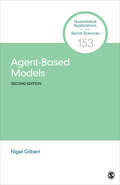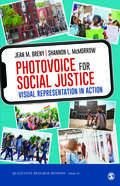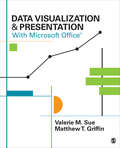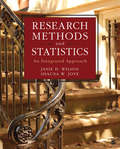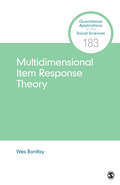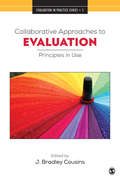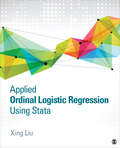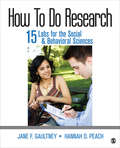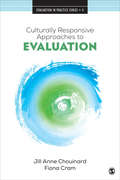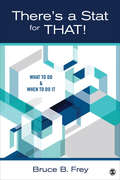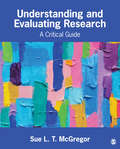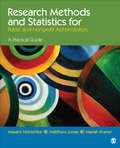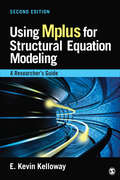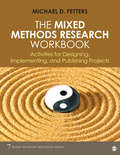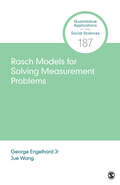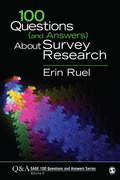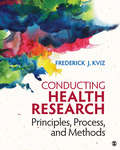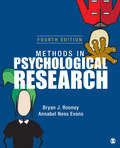- Table View
- List View
Agent-Based Models: Agent-based Modelling Using The Skin Platform (Quantitative Applications in the Social Sciences #153)
by Nigel GilbertAgent-based simulation has become increasingly popular as a modeling approach in the social sciences because it enables researchers to build models where individual entities and their interactions are directly represented. The Second Edition of Nigel Gilbert′s Agent-Based Models introduces this technique; considers a range of methodological and theoretical issues; shows how to design an agent-based model, with a simple example; offers some practical advice about developing, verifying and validating agent-based models; and finally discusses how to plan an agent-based modelling project, publish the results and apply agent-based modeling to formulate and evaluate social and economic policies.
Photovoice for Social Justice: Visual Representation in Action (Qualitative Research Methods)
by Jean M. Breny Shannon L. McMorrowPhotovoice for Social Justice, the latest volume in SAGE′s Qualitative Research Methods Series, helps readers in the health and social sciences learn the foundations and applications of this exciting qualitative method. Authors Jean M. Breny and Shannon L. McMorrow approach photovoice as not only a community-based participatory research method, but as a method for social justice, centering community participants, organizations, and policy makers at the heart of this research method. Special topics relating to social justice include a focus on ethics and working with marginalized communities, sensitive concerns during data collection, and presenting the work to communities and policymakers, as well as academics. Written for students and researchers new to photovoice, this brief text takes readers from the process of conceptualizing and implementing a photovoice study to analyzing data and finally presenting the results of the study. The book concludes with suggestions for future iterations of photovoice, including web based resources and digital storytelling. The authors take into account the realities of photovoice as a method by providing practical, applied tools including sample consent forms, presentations, recruitment flyers, and photo-taking tips. Using Photovoice for Social Justice, new and experienced researchers can design, implement, and analyze their photovoice projects.
Data Visualization & Presentation With Microsoft Office
by Valerie M. Sue Matthew T. GriffinWritten for students, professionals, and social scientists with little or no knowledge of data visualization principles, this complete guide presents step-by-step instructions for clearly and effectively presenting data using MS Office programs. Throughout the book, the focus is on turning raw, quantitative data into attractive, well-designed charts and tables that tell an accurate narrative about underlying information. Helpful illustrations, expert tips for solving common issues, and discussions on working efficiently are included to equip readers with the tools they need to engage their audience using a visual format.
Research Methods and Statistics: An Integrated Approach
by Janie H. Wilson Shauna W. JoyeThis innovative text offers a completely integrated approach to teaching research methods and statistics by presenting a research question accompanied by the appropriate methods and statistical procedures needed to address it. Research questions and designs become more complex as chapters progress, building on simpler questions to reinforce student learning. Using a conversational style and research examples from published works, this comprehensive book walks readers through the entire research process and includes ample pedagogical support for SPSS, Excel, and APA style.
Multidimensional Item Response Theory (Quantitative Applications in the Social Sciences #183)
by Wes BonifaySeveral decades of psychometric research have led to the development of sophisticated models for multidimensional test data, and in recent years, multidimensional item response theory (MIRT) has become a burgeoning topic in psychological and educational measurement. Considered a cutting-edge statistical technique, the methodology underlying MIRT can be complex, and therefore doesn’t receive much attention in introductory IRT courses. However author Wes Bonifay shows how MIRT can be understood and applied by anyone with a firm grounding in unidimensional IRT modeling. His volume includes practical examples and illustrations, along with numerous figures and diagrams. Multidimensional Item Response Theory includes snippets of R code interspersed throughout the text (with the complete R code included on an accompanying website) to guide readers in exploring MIRT models, estimating the model parameters, generating plots, and implementing the various procedures and applications discussed throughout the book.
Collaborative Approaches to Evaluation: Principles in Use (Evaluation in Practice Series #3)
by J. Bradley CousinsEditor J. Bradley Cousins and colleagues meet the needs of evaluators seeking to implement collaborative and participatory approaches to evaluation in Collaborative Approaches to Evaluation: Principles in Use. Using a multi-phase empirical process to develop and validate a set of principles to guide collaborative approaches to evaluation, the book outlines the principles that the team developed, and then provides case studies of how these principles have been applied in practice. The case studies draw on programs globally in education, health, and community development. The book is an invaluable supplementary text for program evaluation courses where students’ projects are focused on more collaborative and participatory approaches, and it is an essential resource for practicing evaluators and those who commission program evaluations.
Applied Ordinal Logistic Regression Using Stata: From Single-Level to Multilevel Modeling
by Xing LiuThe first book to provide a unified framework for both single-level and multilevel modeling of ordinal categorical data, Applied Ordinal Logistic Regression Using Stata helps readers learn how to conduct analyses, interpret the results from Stata output, and present those results in scholarly writing. Using step-by-step instructions, this non-technical, applied book leads students, applied researchers, and practitioners to a deeper understanding of statistical concepts by closely connecting the underlying theories of models with the application of real-world data using statistical software. An open-access website for the book contains data sets, Stata code, and answers to in-text questions.
How To Do Research: 15 Labs for the Social & Behavioral Sciences
by Jane F. Gaultney Hannah D. PeachDesigned to help students make the leap from learning about research to doing research, this manual provides an easy-to-understand walkthrough of the entire research process, from selecting a topic and conducting a literature review through presenting an APA-style paper or presentation. All of the 15 cross-disciplinary labs included are appropriate for use in the social, behavioral, and health sciences, and follow a consistent format: objective, description of a journal article, canned data, examples of what output should look like, pointers on interpreting the output, and a suggested activity for those who wish to collect their own data.
Video Ethnography in Practice: Planning, Shooting, and Editing for Social Analysis
by Wesley M. Shrum Gregory S. ScottVideo Ethnography in Practice is a brief guide for students in the social disciplines who are required to produce an ethnographic video, the most significant new methodological technique in 21st century social analysis. The authors, both accomplished videographers, cover the basic techniques of creating a video that documents human culture and behavior with true stories of the process of videography throughout. This text shows how new technologies like smart phones, widely available video editing software, and YouTube, have turned video ethnography into something that is within reach of students in a conventional course framework.
Culturally Responsive Approaches to Evaluation: Empirical Implications for Theory and Practice (Evaluation in Practice Series #4)
by Fiona Cram jill ChouinardEvaluators have always worked in diverse communities, and the programs they evaluate are designed to address often intractable socio-political and economic issues. Evaluations that explicitly aim to be more responsive to culture and cultural context are, however, a more recent phenomenon. In this book, Jill Anne Chouinard and Fiona Cram utilize a conceptual framework that foregrounds culture in social inquiry, and then uses that framework to analyze empirical studies across three distinct cultural domains of evaluation practice (Western, Indigenous and international development). Culturally Responsive Approaches to Evaluation provide a comparative analysis of these studies and discuss lessons drawn from them in order to help evaluators extend their current thinking and practice. They conclude with an agenda for future research.
There′s a Stat for That!: What to Do & When to Do it
by Bruce B. FreyBruce Frey’s There’s a Stat for That! is a brief, straightforward, and to-the-point guide to deciding which statistical analysis to use and when to use it. Designed for consultants, researchers, students, and those who already have the resources to tell them how to perform the analyses, this text explains why a particular statistical approach is the right one to use. The book affirms that regardless of the group design, once the variables are chosen and the measurement strategy is worked out, one can rest assured that there is a stat for that!
Understanding and Evaluating Research: A Critical Guide
by Sue L. McGregorUnderstanding and Evaluating Research: A Critical Guide shows students how to be critical consumers of research and to appreciate the power of methodology as it shapes the research question, the use of theory in the study, the methods used, and how the outcomes are reported. The book starts with what it means to be a critical and uncritical reader of research, followed by a detailed chapter on methodology, and then proceeds to a discussion of each component of a research article as it is informed by the methodology. The book encourages readers to select an article from their discipline, learning along the way how to assess each component of the article and come to a judgment of its rigor or quality as a scholarly report.
Research Methods and Statistics for Public and Nonprofit Administrators: A Practical Guide
by Masami Nishishiba Mariah A. Kraner Matthew A. Jones"The approach is well executed. The problems encountered by [the characters] represent real-life issues than administrators are faced with and the applications needed to address them." —Lee W. Payne, Stephen F. Austin State University Research Methods and Statistics for Public and Nonprofit Administrators: A Practical Guide is a comprehensive, easy-to-read, core text that thoroughly prepares readers to apply research methods and data analysis to the professional environments of public and non-profit administration. The authors expertly incorporate original case examples to demonstrate concepts using "real actors," facing specific scenarios, in which research methods must be applied. This unique approach—presented in language accessible to both students new to research as well as current practitioners—guides the reader in fully understanding the research options detailed throughout the text.
Using Mplus for Structural Equation Modeling: A Researcher′s Guide
by E . KellowayIdeal for researchers and graduate students in the social sciences who require knowledge of structural equation modeling techniques to answer substantive research questions, Using Mplus for Structural Equation Modeling provides a reader-friendly introduction to the major types of structural equation models implemented in the Mplus framework. This practical book, which updates author E. Kevin Kelloway’s 1998 book Using LISREL for Structural Equation Modeling, retains the successful five-step process employed in the earlier book, with a thorough update for use in the Mplus environment. Kelloway provides an overview of structural equation modeling techniques in Mplus, including the estimation of confirmatory factor analysis and observed variable path analysis. He also covers multilevel modeling for hypothesis testing in real life settings and offers an introduction to the extended capabilities of Mplus, such as exploratory structural equation modeling and estimation and testing of mediated relationships. A sample application with the source code, printout, and results is presented for each type of analysis.
Credible and Actionable Evidence: The Foundation for Rigorous and Influential Evaluations
by Stewart I. Donaldson Melvin M. Mark Christina A. ChristieAddressing one of the most important and contentious issues challenging applied research and evaluation practice today—what constitutes credible and actionable evidence?—this volume offers a balanced and current context in which to analyze the long-debated quantitative-qualitative paradigms. In the Second Edition, the contributors, a veritable "who’s who" in evaluation, discuss the diversity and changing nature of credible and actionable evidence; offer authoritative guidance about using credible and actionable evidence; explain how to use it to provide rigorous and influential evaluations; and include lessons from their own applied research and evaluation to suggest ways to address the key issues and challenges. Reflecting the latest developments in the field and covering both experimental and non-experimental methods, the new edition includes revised and updated chapters, summaries of strengths and weaknesses across varied approaches, and contains diverse definitions of evidence. Also included are two new chapters on assessing credibility and synthesizing evidence for policy makers. This is a valuable resource for students and others interested in how to best study and evaluate programs, policies, organizations, and other initiatives designed to improve aspects of the human condition and societal well-being.
The Mixed Methods Research Workbook: Activities for Designing, Implementing, and Publishing Projects (Mixed Methods Research Series #7)
by Michael D. FettersWritten by Michael D. Fetters, one of the leading scholars in the field and co-editor of the Journal of Mixed Methods Research, The Mixed Methods Research Workbook: Activities for Designing, Implementing, and Publishing Projects is the perfect tool for doctoral students and researchers who want support throughout their research project, as well as a practical way to apply the knowledge they’ve learned. With The Mixed Methods Research Workbook, you’ll be ready to tackle your mixed methods research project with confidence. Each chapter follows a familiar framework, starting with learning objectives for each piece of the mixed methods process. Readers have ample space in this text to write notes, fill out activities, and begin their process of actively designing and writing up a mixed methods study. This easy-to follow process gives readers an immediate structure to their projects. Exemplar boxes provide a starting framework, with the text encouraging deeper reflection on mixed methods challenges and opportunities. Stories from the field illuminate struggles and suggestions with the benefit of hindsight. Checklists at the end of each chapter help readers stay organized and key resources provide up-to-date lists of material for further study. From start to finish, readers can follow along with this text as they work on their projects. The text begins by assisting readers in identifying topics and conducting literature reviews in the context of mixed methods, zeroing in to address mixed-methods-specific challenges like integration, leveraging advantages of both qualitative and quantitative methods, and incorporating theory and personal backgrounds. Identifying data sources helps readers organize their data collection. Two chapters on research designs structure the data collection process with procedural diagrams. A unique chapter on mixed methods sampling offers application through basic and advanced designs. The book illustrates integrating and implementing mixed methods designs with practical advice for each of stage of the process. Ethics in a mixed methods context readies readers for the research protocol stage. Several chapters fully explicate the data analysis process, including developing a joint display, a state-of-the-art procedure for analysis and presentation of findings. Closing out the process, the text tackles quality and evaluation in mixed methods studies, preparing your study for publication, and writing up your article.
Culturally Responsive Approaches to Evaluation: Empirical Implications for Theory and Practice (Evaluation in Practice Series #4)
by Fiona Cram jill ChouinardEvaluators have always worked in diverse communities, and the programs they evaluate are designed to address often intractable socio-political and economic issues. Evaluations that explicitly aim to be more responsive to culture and cultural context are, however, a more recent phenomenon. In this book, Jill Anne Chouinard and Fiona Cram utilize a conceptual framework that foregrounds culture in social inquiry, and then uses that framework to analyze empirical studies across three distinct cultural domains of evaluation practice (Western, Indigenous and international development). Culturally Responsive Approaches to Evaluation provide a comparative analysis of these studies and discuss lessons drawn from them in order to help evaluators extend their current thinking and practice. They conclude with an agenda for future research.
Rasch Models for Solving Measurement Problems: Invariant Measurement in the Social Sciences (Quantitative Applications in the Social Sciences)
by George Engelhard Jue WangThis book introduces current perspectives on Rasch measurement theory with an emphasis on developing Rasch-based scales. Rasch measurement theory represents a paradigm shift in measurement theory away from classical test theory and creates a framework for scaling that can yield invariant measurement. Rasch Models for Solving Measurement Problems: Invariant Measurement in the Social Sciences is a broadly accessible text. Authors George Engelhard Jr and Jue Wang introduce Rasch measurement theory step by step, with chapters on scale construction, evaluation, maintenance, and use. Points are illustrated and techniques are demonstrated through an extended example: The Food Insecurity Experience (FIE) Scale. The Rasch analyses in the book are run using the Facets computer program. Facets syntax, and R code for the ERMA program created by the authors to obtain parameter estimates and to examine model-data fit, together with sample data sets are all available on a website for the book.
100 Questions (SAGE 100 Questions and Answers #6)
by Erin RuelErin Ruel′s 100 Questions (and Answers) About Survey Research covers the entire survey research process, starting with developing research questions and ending with the analysis and write-up. It includes the traditional survey topics of design, sampling, question writing, and validity; includes a chapter on research ethics; covers the important topics of preparing, cleaning, and analyzing data; and ends with a section on how to write up survey results for a variety of purposes. Useful as a supplementary text in the classroom or as a reference guide for anyone starting a new survey project, the guidance is presented in a FAQ style to allow readers to jump around the book, so as to accommodate the nonlinear and iterative nature of research.
There′s a Stat for That!: What to Do & When to Do it
by Bruce B. FreyBruce Frey’s There’s a Stat for That! is a brief, straightforward, and to-the-point guide to deciding which statistical analysis to use and when to use it. Designed for consultants, researchers, students, and those who already have the resources to tell them how to perform the analyses, this text explains why a particular statistical approach is the right one to use. The book affirms that regardless of the group design, once the variables are chosen and the measurement strategy is worked out, one can rest assured that there is a stat for that!
Applied Ordinal Logistic Regression Using Stata: From Single-Level to Multilevel Modeling
by Xing LiuThe first book to provide a unified framework for both single-level and multilevel modeling of ordinal categorical data, Applied Ordinal Logistic Regression Using Stata helps readers learn how to conduct analyses, interpret the results from Stata output, and present those results in scholarly writing. Using step-by-step instructions, this non-technical, applied book leads students, applied researchers, and practitioners to a deeper understanding of statistical concepts by closely connecting the underlying theories of models with the application of real-world data using statistical software. An open-access website for the book contains data sets, Stata code, and answers to in-text questions.
Collaborative Inquiry for Educators: A Facilitator′s Guide to School Improvement
by Jenni Anne DonohooYour step-by-step guide to making collaborative inquiry work Collaborating for improved student outcomes makes sense. But beyond theory, do you know where to begin? How does a team gather, analyze, and then implement and evaluate learning objectives while engaging students and meeting school agendas? Without directed guidance, it’s easier said than done. Aligned to current Learning Forward standards and based on the latest professional development research, Collaborative Inquiry for Educators deconstructs the collaborative inquiry process. This step-by-step guide gives facilitators tools to move teams toward purposeful, productive, and impactful collaborative work, including A clear and concise four-stage model that provides a structure for facilitating successful collaborative inquiry Real-world examples from collaborative teams that model components of each stage Clear, direct, and practitioner-focused tone with an emphasis on action over theory Unlock your team’s ability to work together to improve instruction and increase student achievement today! "Jenni Donohoo′s immensely thoughtful and deeply practical discussion of collaborative inquiry helps teachers to live up to, and also be enlivened by, the high standards of evidence-informed judgment that define all true professions." —Andy Hargreaves, Thomas More Brennan Chair in Education Boston College "In clear and unpretentious language, Donohoo guides the reader through a challenging but practical four-step learning sequence so that teachers learn and, subsequently, students achieve—a goal to which we all subscribe and endorse." —Shirley M. Hord, Scholar Laureate Learning Forward
Conducting Health Research: Principles, Process, and Methods
by Frederick J. KvizConducting Health Research: Principles, Process, and Methods presents an integrated and practical introduction to the principles and strategies for planning, implementing, reporting, and assessing health sciences research. Comprehensive in its breadth and depth, with an accessible writing style, this text prepares students in public health and related fields to be adept researchers and consumers of health research. Through real-world examples and step-by-step guidance, Frederick J. Kviz provides students with the skills they need to: identify and evaluate research strengths and limitations as practitioners; to actually perform the various core aspects of research; and to choose among alternative methods when making decisions about health practice, policy, and future research needs.
100 Questions (SAGE 100 Questions and Answers #6)
by Erin RuelErin Ruel′s 100 Questions (and Answers) About Survey Research covers the entire survey research process, starting with developing research questions and ending with the analysis and write-up. It includes the traditional survey topics of design, sampling, question writing, and validity; includes a chapter on research ethics; covers the important topics of preparing, cleaning, and analyzing data; and ends with a section on how to write up survey results for a variety of purposes. Useful as a supplementary text in the classroom or as a reference guide for anyone starting a new survey project, the guidance is presented in a FAQ style to allow readers to jump around the book, so as to accommodate the nonlinear and iterative nature of research.
Methods in Psychological Research
by Annabel Ness Evans Bryan J. RooneyMethods in Psychological Research introduces students to the rich world of research in psychology through student-friendly writing, compelling real-world examples, and frequent opportunities for practice. Using a relaxed yet supportive tone that eases student anxiety, the authors present a mixture of conceptual and practical discussions, and spark reader interest in research by covering meaningful topics that resonate with today’s students. In-text features like Conceptual Exercises, FYI sections, and FAQ sections with accompanying visual cues support learning throughout the research experience. The Fourth Edition equips students with the tools they need to understand research concepts, conduct their own experiments, and present their findings.
